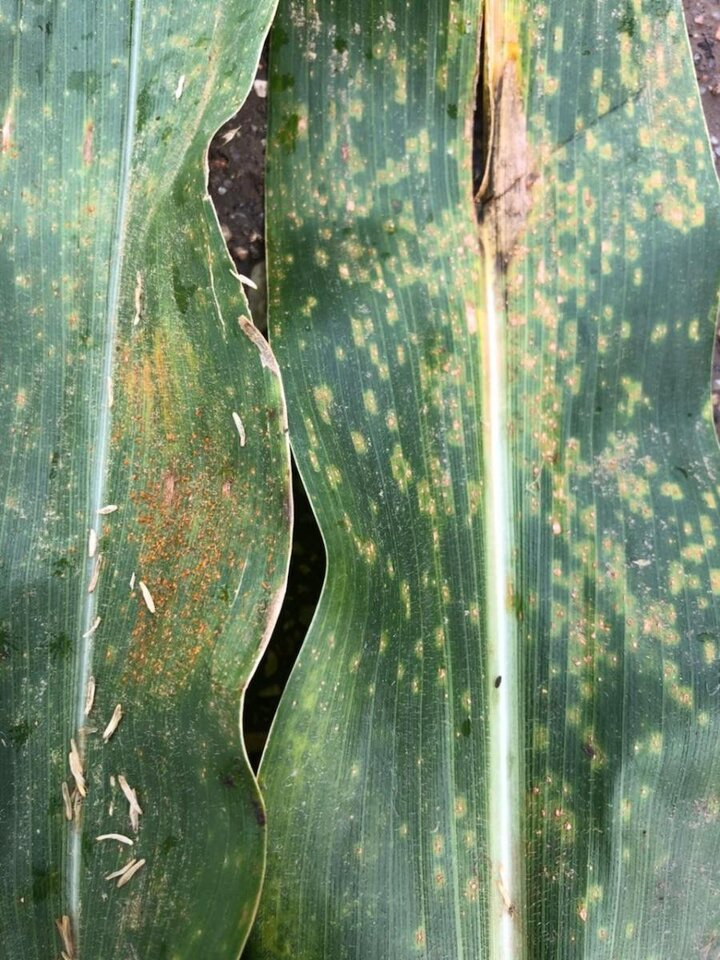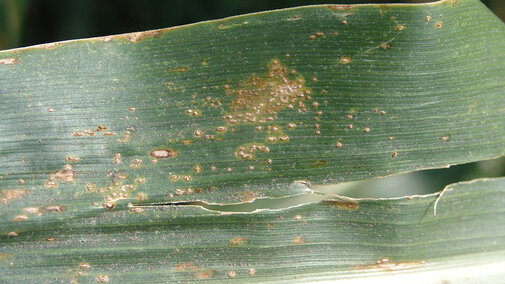Southern corn rust was confirmed in corn leaf samples from Fillmore, Saunders, and Thayer counties (Figures 1-3) in eastern Nebraska earlier this week. The disease had been confirmed in western Missouri and southern Kansas in the prior week after very little confirmed southern rust activity in southern states. The disease currently appears to be at very low incidence in the fields from where samples were submitted. Cooler temperatures may help to slow disease spread, so monitoring the weather forecast will help to anticipate disease behavior. Fields should be scouted soon and frequently in the coming weeks for this and other diseases in case treatment is necessary.



Southern rust is caused by an aggressive fungus that can cause disease to rapidly develop in susceptible corn hybrids under favorable weather conditions. The disease can cause significant yield loss in susceptible hybrids if it becomes severe, so producers and crop advisors should monitor closely for this disease. Sometimes southern rust does not become widespread or severe and does not always require treatment, making scouting and disease monitoring critical. It may take two or more weeks under favorable weather conditions for the disease to become more severe. Severe disease can also impact stalk strength and standability.
Favorable Weather
The pathogen does not overwinter and so its spores (urediniospores) must be blown into the area by wind from the south. The fungus needs moisture to germinate and infect, so high relative humidity, rainfall, irrigation, etc. will hasten disease development. Warm temperatures also favor southern rust development, especially temperatures in the upper 70s to lower 80s F, which are optimal for the fungus, even if they occur during the overnight hours. Cooler and drier conditions will help to slow disease spread, such as what was observed in 2017 when the disease was confirmed in southeast Nebraska early in the growing season and failed to become widespread in most counties.
Monitoring
A new southern rust tracking website has been created to help document the distribution of the disease nationally.
Please help us keep the map updated by sharing samples with southern rust. Samples submitted to the UNL Plant and Pest Diagnostic Clinic that are microscopically confirmed will be highlighted in red on the map, while other samples that look probable for southern rust in photos will be highlighted in yellow to indicate that the disease is “suspected” until a positive sample is submitted from that county.
Management
Most hybrids are susceptible to the southern rust fungus. Familiarize yourself with your hybrids’ anticipated reactions (seed company catalogs) to southern rust to know which ones may need treatment. Foliar fungicides can effectively manage the disease. Most systemic fungicides can provide protection of leaves from future infections for up to 21-28 days.
The wide range of planting dates across Nebraska this year has resulted in a wide range of corn growth and reproductive stages in fields, some of which are still in the vegetative growth stages. Later planted fields that are earlier in their maturity are at the greatest risk for yield loss if the disease develops there soon. Southern rust can sometimes take days to several weeks to develop once it’s identified in an area, so immediate treatment may not be necessary for most fields.
Spraying early may mean a second application is necessary later in the season to protect plants during later grain fill stages as the disease increases in severity once the fungicide has worn off.
Sample Submission
Submit samples to the UNL Plant and Pest Diagnostic Clinic for help identifying this and other diseases. The clinic site has information on how to submit a sample and the sample submission form.

